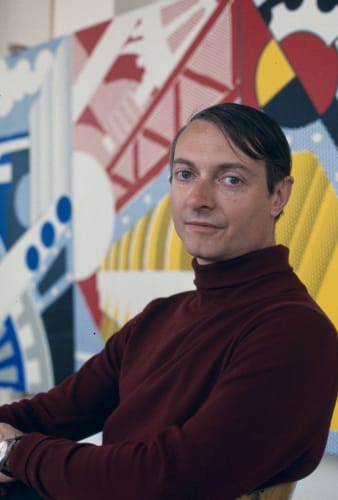Roy Lichtenstein was one of the most important figures of the 20th-century Pop Art movement. By borrowing visual language from comic strips, advertising, and mass production, he reshaped the boundaries of fine art. His works not only reproduced the imagery of American culture but elevated and transformed it—showing how media saturates everyday life and influences our sense of beauty, drama, and identity. This article explores Lichtenstein’s ten most famous works in depth, unpacking how each one crystallizes his style and vision.
1. Whaam! (1963)
Perhaps Lichtenstein’s most celebrated canvas, Whaam! is a massive diptych that depicts two fighter planes locked in combat. On the left, a sleek American jet fires a rocket; on the right, its target explodes into a brilliant fireball, accompanied by the oversized comic-book onomatopoeia “WHAAM!”
-
Source and Style: Based on a 1962 panel from DC Comics’ All-American Men of War, Lichtenstein drastically simplified the composition, reducing shading to flat colors and dots while amplifying its scale to mural size (over four meters wide).
-
Themes: The work embodies postwar America’s fascination with technology, speed, and military power while also satirizing the glamorization of war in mass entertainment. Coming at the height of the Cold War, it reflects anxieties about real conflict while presenting violence as stylized spectacle.
-
Legacy: Displayed at Tate Modern, it has become a Pop Art landmark, widely reproduced and studied as an example of how high art can absorb and critique mass media simultaneously.
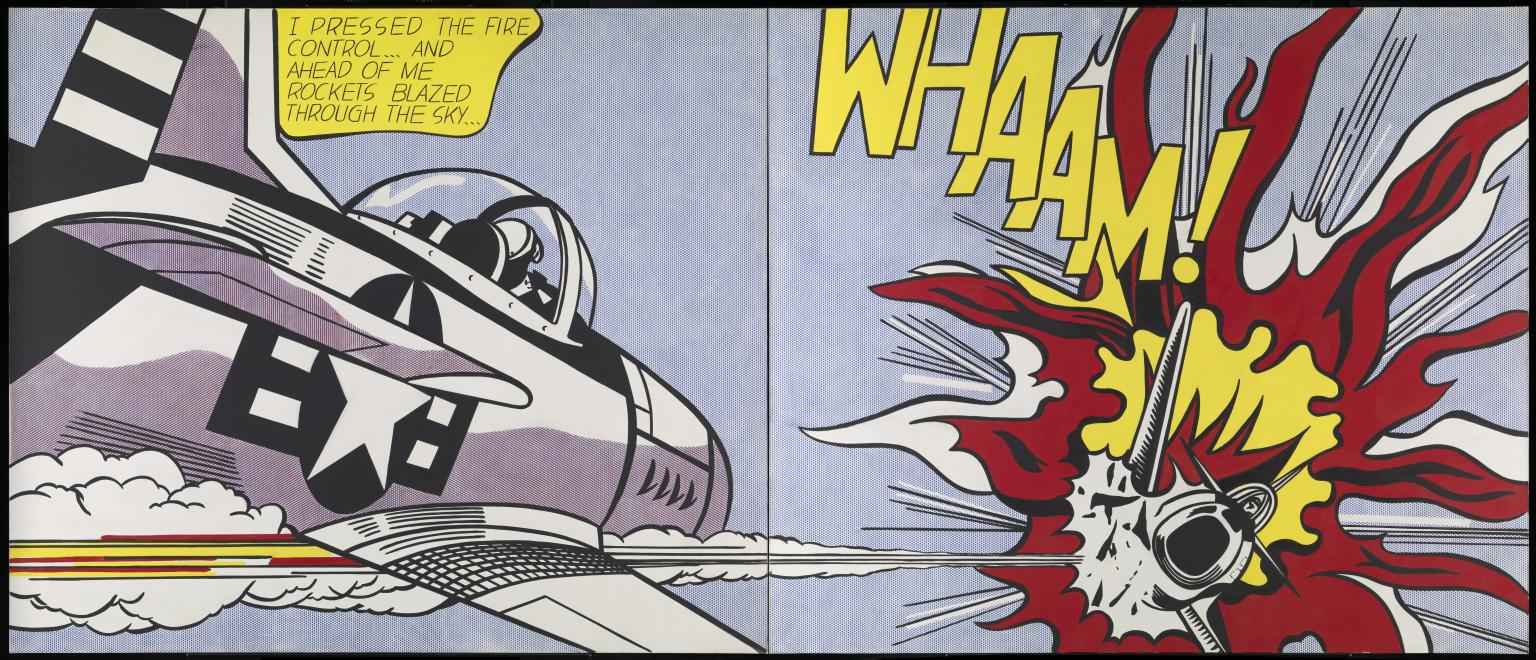
2. Drowning Girl (1963)
This painting portrays a tearful young woman engulfed by stylized blue waves. A speech bubble declares: “I Don’t Care! I’d Rather Sink—Than Call Brad For Help!”
-
Emotional Impact: Adapted from a romance comic by Tony Abruzzo, Lichtenstein cropped out the male figure, focusing solely on the woman’s face and hand. This shift turns the image into a powerful study of melodrama, isolation, and independence.
-
Technique: The water’s arcs and curls are abstracted into geometric waves, balancing emotional intensity with formal elegance. The tears, rendered in dots, exaggerate the theme of despair while making it oddly mechanical.
-
Interpretation: Critics often read this painting as a feminist commentary, whether intentional or not, highlighting the depiction of women in mass culture as emotional, vulnerable, yet visually commodified.
-
Status: Today it is one of MoMA’s most famous Lichtensteins, symbolizing his ability to transform pulp imagery into timeless art.
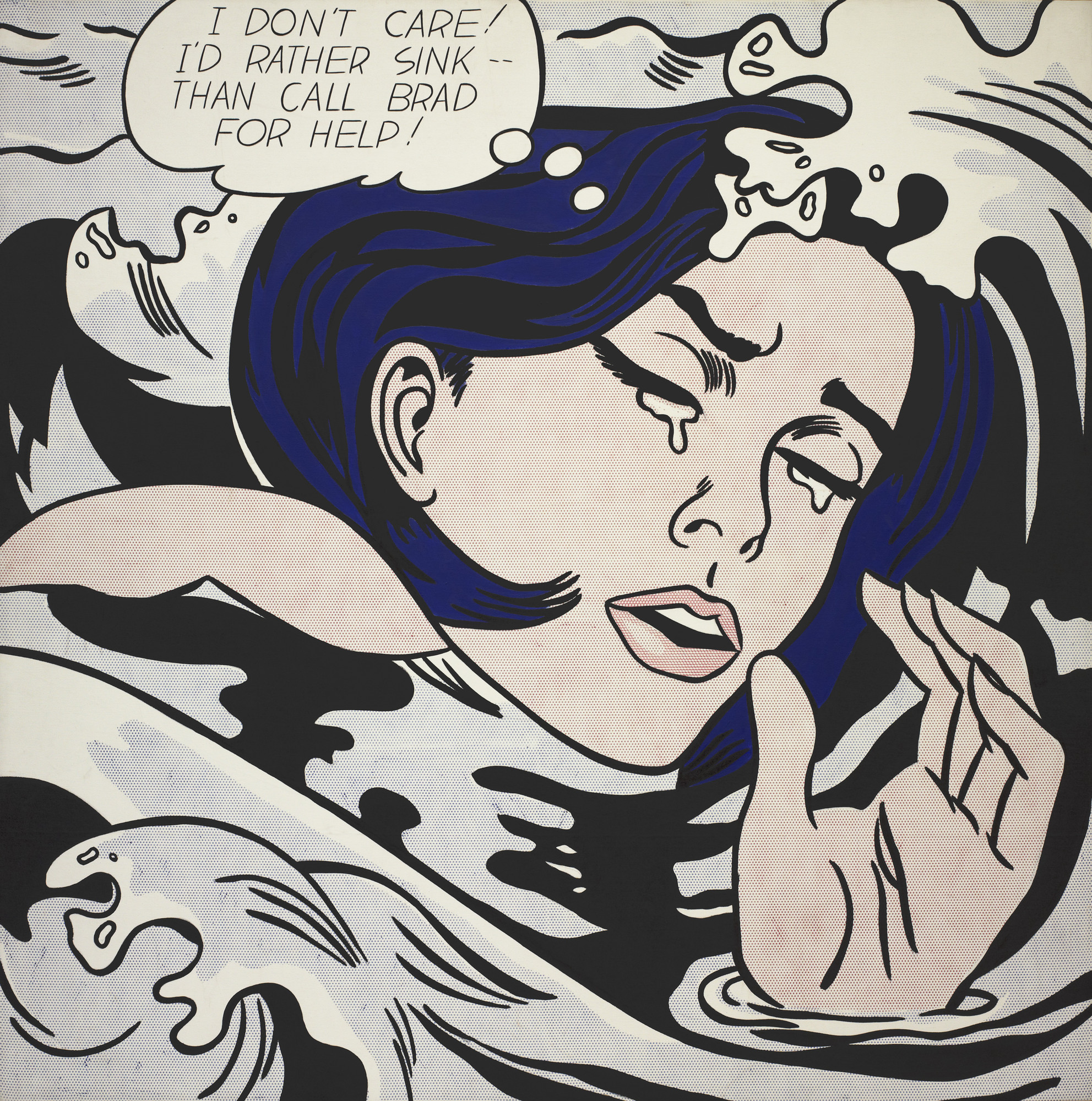
3. Look Mickey (1961)
Look Mickey is often considered the turning point in Lichtenstein’s career. It shows Donald Duck laughing at Mickey Mouse, who is holding a fishing rod—apparently hooked on his own shirt.
-
Why It Matters: This was the first painting in which Lichtenstein used Ben-Day dots, bold outlines, and speech balloons—all trademarks of his mature style. From Abstract to Pop: Prior to this, Lichtenstein painted in an Abstract Expressionist mode. With Look Mickey, he embraced popular imagery, signaling his decisive break into Pop Art.
-
Tone: The humor and self-deprecation (“Look, Mickey, I’ve hooked my whole shirt!”) mirror Lichtenstein’s playful engagement with art history. By using beloved cartoon characters, he blurred the line between high art and childhood ephemera.
-
Reception: Though initially dismissed as unserious, this canvas now hangs in the National Gallery of Art, Washington, as a monument to the origins of Pop.

4. Masterpiece (1962)
In Masterpiece, a blonde woman reassures her lover, Brad, with the words: “Why, Brad darling, this painting is a masterpiece! My, soon you’ll have all of New York clamoring for your work!”
-
Meta Commentary: This painting cheekily predicted Lichtenstein’s own career. Within just a few years, he would indeed have New York “clamoring” for his canvases.
-
Irony: The title and dialogue parody the language of art-world success. Is the painting really a “masterpiece,” or is the word itself a product of hype and desire?
-
Art Market: In 2017, Masterpiece sold for $165 million, making it one of the most expensive works of postwar art. The irony deepened: the joke about fame and market demand became prophetic.
-
Aesthetic Significance: Beyond irony, the work is a perfect example of Lichtenstein’s formula: pared-down forms, impeccable flatness, and deadpan melodrama.
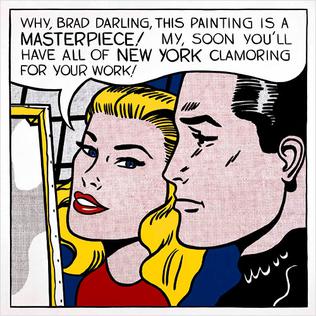
5. Girl with Ball (1961)
This early Pop painting shows a young woman in a bikini holding a beach ball, smiling brightly.
-
Source Material: Taken from a brochure for the Mount Airy Lodge, a Poconos resort, the original image promised leisure and romance.
-
Lichtenstein’s Transformation: He stripped away detail, reducing the figure to blocks of primary color and Ben-Day dots. The woman becomes less individual, more archetype—a perfect emblem of American advertising’s ideal of femininity.
-
Themes: It captures the optimism of early 1960s Americana—beach holidays, leisure, beauty—while also revealing the mechanical way such ideals were mass produced.
-
Historical Role: As one of his earliest comic-based works, it shows Lichtenstein moving fully into Pop vocabulary.
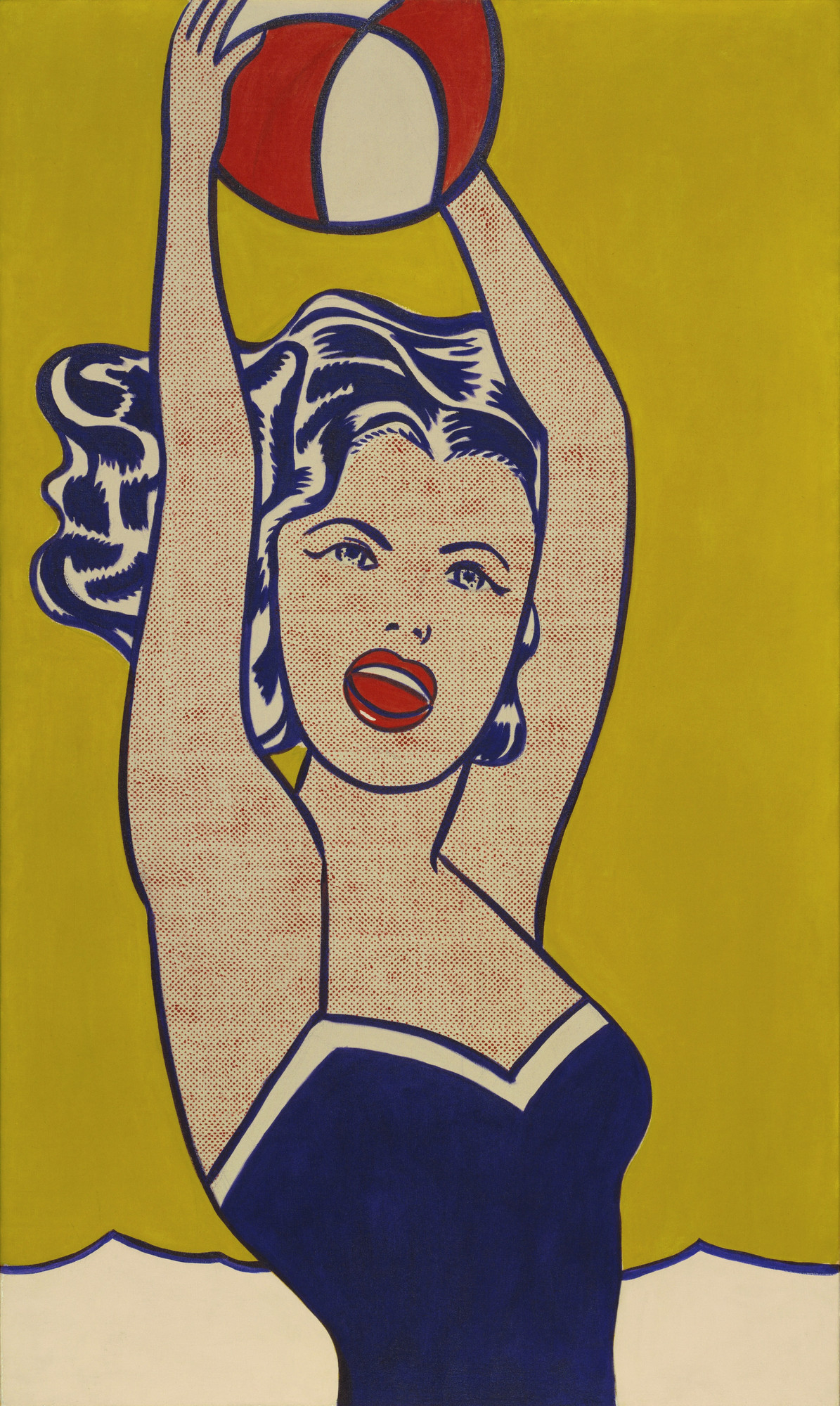
6. Oh, Jeff... I Love You, Too... But... (1964)
This portrait of a blonde woman captures a moment of hesitation. Her lips part slightly, her eyes gaze upward, and a speech bubble reveals the words: “Oh, Jeff... I Love You, Too... But...”
-
Narrative Ambiguity: The abrupt ending (“But...”) invites speculation—what comes next? Is the relationship ending? The drama lies in the ellipsis.
-
Stylistic Power: Cropped tightly around the woman’s face, the image becomes a study of emotion conveyed through minimal lines and dots.
-
Gender Commentary: Like many of his romance paintings, it reflects how women were portrayed in pulp culture: always caught in heightened emotional states, defined in relation to men.
-
Legacy: It remains one of Lichtenstein’s most reproduced images, illustrating how he captured entire stories in a single frame.

7. M-Maybe (1965)
This work portrays another archetypal blonde woman, gazing anxiously with her hand raised to her cheek. A thought bubble reads: “M-Maybe he became ill and couldn’t leave the studio!”
-
Suspense: The text is mundane, but when paired with her expression, it conveys anxiety, longing, and melodrama.
-
Artistic Approach: Lichtenstein isolates her against a flat yellow background, intensifying the focus on her emotion.
-
Interpretation: This piece shows how mass media condensed complex human emotions into clichés, which Lichtenstein then amplified for critical effect.
-
Critical Reception: M-Maybe is often cited as a high point in his romance paintings, illustrating his ability to crystallize narrative into static yet dynamic form.

8. Bulls Series (1973)
Departing from comics, this series focused on the animal as subject. Across a sequence of six prints, Lichtenstein deconstructs the image of a bull, moving from near-naturalism to pure abstraction.
-
Art-Historical Roots: The bull was a classical subject, famously tackled by Picasso. Lichtenstein’s series pays homage to this tradition while also parodying it through Pop formalism.
-
Process: Each image strips away more detail, until the final bull is reduced to abstract shapes and dots.
-
Themes: It shows Lichtenstein’s interest in how representation can shift from realism to symbolism through a systematic process.
-
Legacy: This series is a reminder that Lichtenstein’s work extended beyond comics, into deeper explorations of art history and abstraction.

9. In the Car (1963)
This painting presents a close-up of a man and woman seated in a car. The man drives, his face stern and forward-facing, while the woman sits beside him, lips tight, eyes cast sideways.
-
Dramatic Tension: Though together in a confined space, the figures appear emotionally distant. The silence is heavy, the tension palpable.
-
Stylistic Notes: The cropping, taken from a 1961 comic panel, intensifies the claustrophobic mood.
-
Cultural Reading: The work speaks to mid-century gender roles and emotional disconnection—presenting an idealized couple who are simultaneously estranged.
-
Critical Acclaim: Today housed at the Scottish National Gallery of Modern Art, it is widely seen as a classic of his “romance” period.

10. Hopeless (1963)
A young woman lies back, tears streaming from her eyes, as a word balloon reads simply: “Hopeless.”
-
Emotional Force: Based on a Tony Abruzzo drawing, the image distills female despair into its starkest visual form.
-
Formal Balance: The tears are geometric, the hair stylized, the skin dotted—emotions become aesthetic patterns.
-
Interpretation: Like Drowning Girl, it critiques the melodramatic way pulp culture represented women. The stylization reduces anguish into design, leaving viewers both moved and distanced.
-
Significance: As one of his most reproduced images, Hopeless exemplifies his gift for elevating clichés into icons of modern art.

Roy Lichtenstein’s top ten works highlight his genius for transforming the everyday into the extraordinary. From fighter jets to beach girls, comic-book melodramas to art-historical bulls, he distilled American culture into bold, picture-perfect scenes that blurred boundaries between mass media and fine art. Each canvas was both homage and critique—celebration and parody. His legacy lies not only in his instantly recognizable style but in his ability to show how images shape the way we see, desire, and remember.
Explore Roy Lichtenstein signed prints for sale and contact our galleries via info@guyhepner.com. Looking to sell? We can help. Find out how to sell your Roy Lichtenstein prints with our teams.